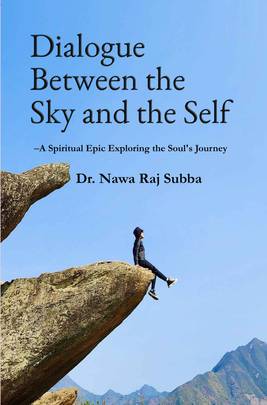
Dialouge Between the Sky and the Self Awakening of Philosophical Travel
Dialouge Between the Sky and the Self Awakening of Philosophical Travel
E-book
Paperback
Currently not available.
Request this bookDeep philosophical, cultural, and poetic epic "Dialogue Between the Sky and the Self" investigates the beginning of creation, the secrets of the five elements, soul introspection, and finally the road to transcendental emancipation. The story is a cosmic dialogue between awareness and the universe, between inner silence and the sky, not only a literary or narrative trip.
Drawing profoundly on Kirat cultural philosophy and the Mundhumic perspective, the poet creates a tapestry of introspective contemplation and legendary images. The poem invites the reader to rediscover the neglected link between spirit and space by unfolding as a metaphysical journey—a discourse between the self and the universe.
Organisation and Thematic Movement
There are five cantos in the epic, each examining a different degree of consciousness and spiritual awakening:
1. The Silence of the Universe: This canto opens with the universe emerging out of primordial emptiness. The metaphysical basis is established with the birth of the five elements, the first pulse of creation, the dance of nature, and the first voice of Mundhum.
2. Path of Tungdunge and Sacred Knowledge: Tungdunge, the primary figure, talks with the five elements and the surroundings. By means of these interactions, he discovers the deeper truths of earth, water, fire, air, and sky, therefore exposing a road to self-awareness and spiritual insight.
3. Struggle and Great War: This part shows interior difficulties as well as outside ones. The conflict of the soul is symbolised by the combat with darkness. Raw images of cosmic and personal upheaval abound from tears of the earth, rivers of blood, and the flames of rebirth.
4. Dharma, law and tradition: Here we investigate the roots of spiritual order, justice, and ancestral knowledge—dharma, law, and tradition. Rich philosophical issues help to expose the conflict of tradition, law, and the changing self.
5. The Final Teachings and the Ascent to the Sky—Tungdunge engages in the ultimate conversation with the five elements as he approaches self-realisation. His spirit starts its voyage towards the void, dissolving into silence to mark release. The poem finishes in continuity rather than finality, therefore confirming that the road never really ends.
All Editions

Share Your Thoughts
Your review helps others make informed decisions
Click on a star to start your review
